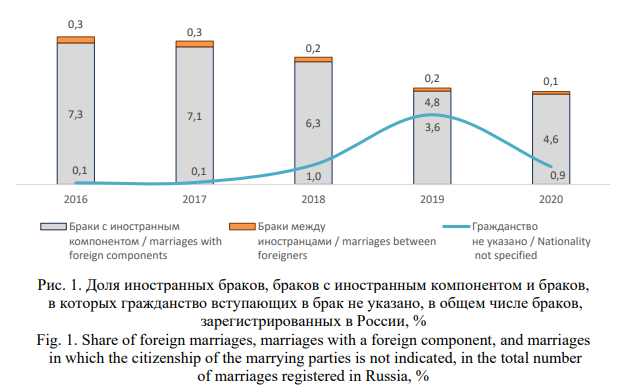The impact of external migration on marriage and fertility in modern Russia
The relevance of this issue is connected with the strengthening of expert and public criticism of Russia's migration policy. Currently, there is a sharp polarization of opinions of the scientific community about the role of external migration on the demographic development of the country, including the processes of marriage and fertility. The scientific problem consisted in the development of research approaches that allow solving theoretical and applied problems of assessing the impact of external migration on the processes of marriage and fertility in modern Russia. Traditional methods of scientific research were used in the work: analysis, synthesis, grouping, comparison, generalization, structural and graphic. The theoretical aspects of this study allowed us, on the basis of the sign of civil status, to form a logical structure of categories of the population exercising marital and reproductive behavior in modern Russia, as well as to introduce the following definitions into the scientific information space: determinate by civil status population and nondetermined by civil status population, as well as Russian marriage and fertility, foreign marriage and fertility, marriage and fertility with a foreign component. The applied results of the work made it possible to obtain a scientifically based assessment of the contribution to the trends of marriage and fertility of certain categories of the population differentiated by nationality, which, in turn, made it possible to obtain a scientifically based idea of the extent of the influence of external migrant flows on the marital and reproductive sphere. The foreign factor, as a result of external migration, tends to increase in the formation of marriage and fertility trends, although its importance is small in modern Russia.
Figures

Sigareva, E. P., Sivoplyasova, S. Yu. (2022), “The impact
of external migration on marriage and fertility in modern Russia”, Research Result.
Sociology and management, 8 (1), 68-81, DOI: 10.18413/2408-9338-2022-8-1-0-6.


















While nobody left any comments to this publication.
You can be first.
Vishnevsky, A. (2012), “Demographic breakthrough or going in cicles? (Part Two)”, DEMOSCOPE Weekly, 535-536, available at: http://www.demoscope.ru/weekly/2012/0535/demoscope535.pdf (Accessed 08 January 2022). (In Russian)
Mammadov, I. B. (2020), “The role of migration processes in demographic development in European countries”, Uchyonye zapiski Krymskogo federal'nogo universiteta imeni I.V. Vernadskogo. Geografiya. Geologiya, 6 (2), 93-105.
Musin, U.R. (2021), “Migration and demographic situation in the region”, Journal of Economy and Business, (In Russian)
Ryazantsev, S.V. (2019), “Modern migration policy of Russia: problems and approaches to improvement”, SOCIS, (9), 117-126, DOI: 10.31857/S013216250006666-5. (In Russian)
Bel-Air, Françoise De. (2014), Demography, Migration, and Labour Market in Qatar, available at: https://goo.su/UXYbRa (Accessed 03 February 2022).
Jang, J. B., Casterline, J. B., & Snyder, A. (2014), Migration and Marriage: Modeling the Joint Process”, Demographic research, 30, 1339-1366, available at: https://doi.org/10.4054/DemRes.2014.30.47 (Accessed 03 February 2022).
Jensen, E. R., Ahlburg, D. A. (2000), The impact of migration on fertility in the Philippines. [Online], available at: https://goo.su/6lBaCfY (Accessed 01 February 2022).
Hawthorne, L. (2008), “Demography, Migration and Demand for International Students”, Globalisation and Tertiary Education in the Asia-Pacific. Hackensack, World Scientific, NJ, 93-119, DOI: 10.1142/9789814299046_0005.
Hyman, I., Guruge, S., Mason, R. (2018), “The Impact of Migration on Marital Relationships: A Study of Ethiopian Immigrants in Toronto”, Journal of Comparative Family Studies, 2 (39), 149-163.
Poveda, A. R., Ortega, J. A. (2010), “The Impact of Migration on Birth Replacement – The Spanish Case”, In: Salzmann T., Edmonston B., Raymer J. (eds.) Demographic Aspects of Migration. VS Verlag für Sozialwissenschaften [Online], available at: https://doi.org/10.1007/978-3-531-92563-9_4 (Accessed 03 February 2022).
Sordilla, Sh. P. G. (2002), The Effects of Migration to the Demography of Mindanao (1903-2018). [Online], available at: https://goo.su/Ye3ck (Accessed 01 February 2022).
Wei-Jun J. Y. & Zheng M. (2020), “Migration and marriage in Asian contexts”, Journal of Ethnic and Migration Studies, 14 (46), 2863-2879, DOI: 10.1080/1369183X.2019.1585005.
Yavcan, B. (2021), “Influence of Long-Term Demographic Trends on Migration Dynamics”, Working Paper, MAGYC project, available at: https://www.magyc.uliege.be/upload/docs/application/pdf/2021-09/d1.4-v1february2021.pdf (Acceessed 01 February 2022).